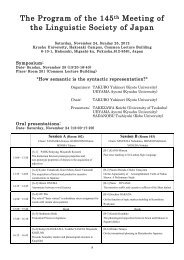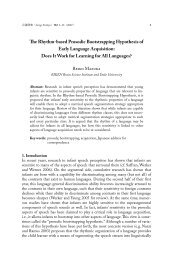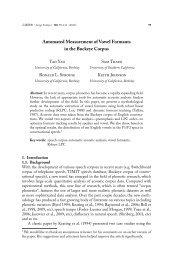第117åæ¥æ¬è§£åå¦ä¼ç·ä¼ã»å ¨å½å¦è¡éä¼ è¬æ¼ããã°ã©ã ã»æé²é PDF ...
第117åæ¥æ¬è§£åå¦ä¼ç·ä¼ã»å ¨å½å¦è¡éä¼ è¬æ¼ããã°ã©ã ã»æé²é PDF ...
第117åæ¥æ¬è§£åå¦ä¼ç·ä¼ã»å ¨å½å¦è¡éä¼ è¬æ¼ããã°ã©ã ã»æé²é PDF ...
You also want an ePaper? Increase the reach of your titles
YUMPU automatically turns print PDFs into web optimized ePapers that Google loves.
178<br />
117 <br />
P<br />
Separatration of early stage acrosome reacted sperm and analyses<br />
of the proteins<br />
Kenji Yamatoya, Chizuru Ito, Cheng Chen, Mamiko Maekawa,<br />
Yoshiro Toyama, Kiyotaka Toshimori<br />
Dept. Anatomy and Developmental Biology, Grad. Sch. Med., Univ. Chiba<br />
During the acrosome reaction, the contents of sperm acrosome are released from<br />
the original location to the final destination and working place. The molecular<br />
distribution and nature are posttranslationally modified. We reported that flow<br />
cytometric analyses using antiacrosomal membrane protein antibodies anti<br />
IZUMO1 and antiSPACA1 can discriminate the early stage of acrosome reaction,<br />
classifying into 7 populations.<br />
In this study, we analyzed the 7 populations and found that the populations<br />
number 4 and 5 contain acrosomeswelling sperm. Acrosomeswelling occurs at<br />
a very early stage of acrosome reaction which starts before the exposure of inner<br />
acrosomal membrane. One of the acrosomal membrane proteins, SPACA1, was<br />
cleaved during this swelling stage. Western blot showed that SPACA1 was 35 kDa<br />
before acrosome reaction and became 21 kDa in acrosomeswelling sperm.<br />
Thus, this flow cytometric method is useful to analyze the detailed acrosome<br />
reaction process and the molecular changes during the acrosome reaction which<br />
are the last preparatory process for the spermegg interaction.<br />
P<br />
Cell adhesion molecule Nectin <br />
<br />
Kannika Adthapanyawanich <br />
<br />
<br />
Cell adhesion molecule1 Cadm1 Nectin3 <br />
Cadm1 <br />
Poliovirus receptor <br />
Nectin3 Nectin2<br />
<br />
Cadm1 Nectin3 <br />
Cadm1 Nectin3 <br />
<br />
Cadm1//Nectin3/ Cadm1/ <br />
Nectin3/ <br />
<br />
<br />
Cadm1 Nectin3 <br />
<br />
P<br />
SF <br />
<br />
<br />
<br />
SF1 <br />
<br />
<br />
2 anti<br />
Müllerian hormone type 2 receptor Cre CreloxP <br />
SF1 <br />
0 21 SF1 <br />
7 <br />
14 21 <br />
<br />
14 21 SF1 <br />
AMH <br />
p27 <br />
WT1SOX9GATA4androgen receptor <br />
SF1 <br />
SF1 <br />
<br />
P<br />
Autoimmune responses induced by immunization with xenogenic<br />
testicular germ cells alone<br />
<br />
<br />
Experimental autoimmune orchitis EAO is one of the models of immunological<br />
male infertility. Classically, the immunization of mice with a testicular<br />
homogenate emulsified in complete Freund's adjuvant followed by intravenous<br />
injections of Bordetella pertussis is necessary for the induction of murine EAO.<br />
Later, we previously established a mouse EAO model that can be induced by two<br />
subcutaneous injections of viable syngeneic testicular germ cells TGC alone,<br />
and the autoantigens involved in the mouse EAO have been analyzed using two<br />
dimensional gel systems and western blotting. In the present study, to examine<br />
whether the xenogenic TGC can induce a mouse EAO, we immunized mice with<br />
viable TGC taken from the rat or the guinea pig. The results showed that mouse<br />
EAO was also inducible by the rat TGC but not the guinea pig TGC. Therefore,<br />
the results suggest that the autoantigens that induce the mouse EAO are present in<br />
not only the mouse TGC but also xenogenic TGC = the rat TGC. Analyses of the<br />
common autoantigens responsible for EAO induction are now in progress.<br />
P<br />
Diethylhexyl phthalate <br />
<br />
<br />
Di2ethylhexyl phthalate=DEHP <br />
<br />
<br />
DEHP <br />
A/J <br />
8 0%0.01%0.1%DEHP 8 <br />
<br />
0.01%DEHP 0.1%DEHP <br />
<br />
0.01%<br />
0.1%DEHP <br />
DEHP <br />
MHC Class RTPCR <br />
DEHP <br />
IL10IFNγ <br />
DEHP <br />
<br />
P<br />
The effect of cadmium on immunoenvironment in the testis<br />
Yuki Ogawa 1,2 , Masahiro Itoh 1 , Shuichi Hirai 1 , Munekazu Naito 1 ,<br />
Ning Qu 1 , Hayato Terayama 1 , Hidenobu Miyaso 2 , Yoshiharu Matsuno 2 ,<br />
Masatoshi Komiyama 2 , Chisato Mori 2<br />
1<br />
Dept. Anat., Tokyo Med. Univ., 2 Dept. Bioenv. Med., Grad. Sch. Med., Chiba Univ.<br />
Cadmium, one of various environmental toxicants, is known to suppress systemic<br />
immunity and to injure the testicular capillary endothelia with resultant necrosis of<br />
testicular tissues in mice and rats treated with high doses. Recently, it also became<br />
evident that cadmium can affect the integrity of the bloodtestis barrier BTB,<br />
the endocrine function of Leydig cells, apoptosis of germ cells and systemic<br />
immunity, even on treatment with a low dose that does not induce spermatogenic<br />
disturbance. Experimental autoimmune orchitis EAO, i.e., an organ<br />
specific autoimmunity of the testis, can be induced by repeated immunization<br />
with testicular antigens, and its pathology is characterized by lymphocytic<br />
inflammation and spermatogenic disturbance. In the present study, we investigated<br />
the morphological and functional changes of testes in mice treated with a low dose<br />
of cadmium chloride CdCl 2 and also examined its toxicity as to susceptibility to<br />
EAO.







